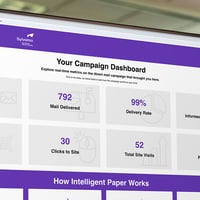An Interview with Graphic Designer Kyndra Bailey

For graphic designer and business owner Kyndra Bailey, inspiration can be something of a surprise, striking at any time and in any place. Her journey in graphic design began as a bit of a surprise as well. Kyndra took up hand-lettering as a hobby just before graduating college, and, while she always loved working with her hands, she quickly realized that this newfound passion for art and design could take her to some new and unexpected places.
Fast forward a few years, Kyndra’s small design business is driven by offering customers high-quality, custom textile and paper products, in particular a series of popular mental health journals — more than 15,000 journals have shipped since the initial launch — that help users document thoughts and feelings related to their mental or emotional health.
Kyndra was kind enough to take a few moments to answer some questions about her philosophy on graphic design, her love of paper and some important advice for young designers as they chart their own course for success.
Accent: Tell us a little bit about your relationship to paper? What roles does it place in practice?
Kyndra Bailey: It quite literally keeps the lights on. My business is made up of two main components, textiles and paper products, the latter of which is the best seller by far. From a more sentimental standpoint, it’s my main vehicle of expressing my creativity, and I wouldn’t be able to do that without paper.
What other tools are critical to your craft?
I do everything digitally, so my iPad/Procreate/Apple Pencil combo is my best friend when it comes to creating designs. Adobe Illustrator and InDesign also deserve an honorable mention.
Anything else you use to ensure you’re creating your best work?
A nice latte and a chill playlist — this is why most of my creative work (including the initial design of my mental health journal) is done at local coffee shops.
What about inspiration? Who or what do you look to in order to find inspiration?
My customers are a huge source of inspiration. They’re constantly sending me ideas and themes they’d like to see, and even sometimes play a role in the design process through Instagram polls. Other than that, I keep a running list of ideas in my phone, because you never know when inspiration is going to come. I’m known for jumping out of bed in the middle of the night just to write down an idea that randomly came to me. That said, creativity is a muscle, and in the early days, I often looked to other businesses for inspiration — never to outright copy, of course.
Let’s talk about your work. Is there a recent project that you’re particularly proud of?
I just introduced sticker grams to my line of products, and it’s by far the most exciting thing I’ve introduced in a while. It combines the fun of small valentines with stickers; they’re 2x3” sticker sheets with a peel-away sticker and message, with a to and from space at the bottom. They were created with Valentine's Day in mind, but are 100% going to be a year-round seller.
Let’s also talk for a second about the mental health journal. What inspired you to create it?
I created my first mental health collection in May 2021, and as soon as I started teasing it, it was clear that mental health was a topic that meant a lot to people. I wanted to take the collection a step further and design something that not only advocated for mental health, but also proved useful for it as well. I designed the first mental health journal in 2021, and it was just check-in pages at the time. I overhauled it in 2022 (before launching my second annual mental health collection), and that’s what you see out in the world today.
What challenges or hurdles did you encounter in designing the mental health journals?
The first version of the journal was initially designed in Procreate, but because it was mostly a text-based item, I knew that wasn’t the best way to do it once I started overhauling it in 2022. I decided to use Adobe Illustrator to design the second version, despite having zero knowledge of how to work it. I’ve since realized InDesign would’ve been a much better platform to design the interior pages on, but that’s neither here nor there.
Do you have a favorite cover?
The Be Kind To Your Mind design was the design that started it all, so she’ll always hold a special place in my heart.
What advice would you give emerging designers who might be looking to follow in your footsteps?
I have two main phrases I’m always repeating to myself: forward is forward is forward and done is better than perfect.
As artists, it’s easy to get caught up in what we don’t know, what skills we have yet to master and all the things that you could have or should have done. But at the end of the day, everything is a learning process, and it doesn’t matter how quickly you learn new things. Eventually, as long as you keep moving forward, you’ll be able to look back and see how far you’ve come. In the words of my favorite artist, Taylor Swift: “don’t [...] polish the doorknob so long [that] you forget to open the door.”
Thank you to Kyndra for making some time for us! Read more about her mental health journal series or visit her website to see more of her work.





